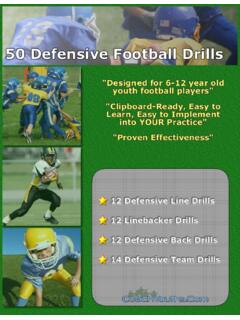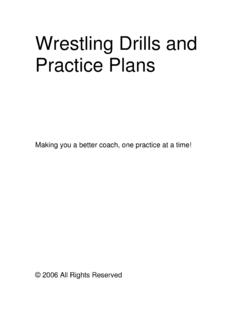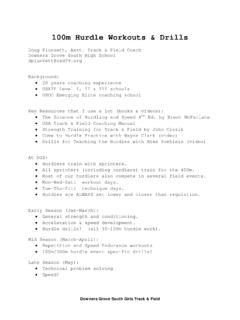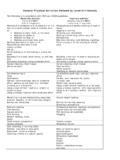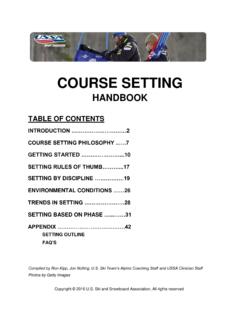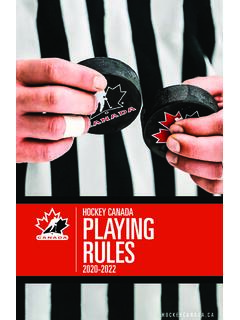Transcription of Volleyball Skills & Drills
1 Volleyball Skills & DrillsAmerican Volleyball Coaches AssociationKinda S. LenbergEditorHuman KineticsiiiLibrary of Congress Cataloging-in-Publication DataVolleyball Skills & Drills / American Volleyball Coaches Association; Kinda Lenberg, editor. p. cm. ISBN 0-7360-5862-1 (soft cover : alk. paper) 1. Volleyball --Training. I. Title: Volleyball Skills & Drills . II. Lenberg, Kinda. III. American Volleyball Coaches Association. 2006 2005017608 ISBN: 0-7360-5862-1 Copyright 2006 by American Volleyball Coaches AssociationThe Web addresses cited in this text were current as of September 2005 unless otherwise Editor: Jana Hunter; Developmental Editor: Kase Johnstun; Assistant Editor: Cory Weber; Copyeditor: John Wentworth; Proofreader: Sarah Wiseman; Graphic Designer: Robert Reuther; Graphic Artist: Tara Welsch; Photo Manager: Dan Wendt; Cover Designer: Keith Blomberg.
2 Photographer (cover): Associated Press; Photographer (interior): Tom Kimmell, unless otherwise noted; Art Manager: Kareema McLendon; Illustrator: K&M Services; Printer: Versa PressWe thank Joan Powell and Coronado High School in Colorado Springs, Colorado, for assistance in providing the location for the photo shoot for this Kinetics books are available at special discounts for bulk purchase. Special editions or book excerpts can also be created to specification. For details, contact the Special Sales Manager at Human in the United States of America 10 9 8 7 6 5 4 3 2 1 Human KineticsWeb site: States: Human Box 5076 Champaign, IL 61825-5076800-747-4457e-mail: Human Kinetics475 Devonshire Road Unit 100 Windsor, ON N8Y 2L5800-465-7301 (in Canada only)e-mail: Human Kinetics107 Bradford RoadStanningleyLeeds LS28 6AT, United Kingdom+44 (0) 113 255 5665e-mail: Human Kinetics57A Price AvenueLower Mitcham, South Australia 506208 8277 1555e-mail: Zealand.
3 Human KineticsDivision of Sports Distributors NZ Box 300 226 AlbanyNorth Shore CityAuckland0064 9 448 1207e-mail: by Taras Liskevych vKey to Diagrams xCHAPTER 1 Serving ..1 Tom PetersonCHAPTER 2 Receiving Serves ..19 Marilyn NolenCHAPTER 3 Setting ..35 Sean ByronCHAPTER 4 Attacking ..53 Jim McLaughlinCHAPTER 5 Blocking ..69 Don HardinCHAPTER 6 Digging ..91 Joan PowellCHAPTER 7 Playing Offense ..111 Joe SagulaCHAPTER 8 Playing Defense ..133 Julie Backstrom and Mike SchallEdited by Russ RoseCHAPTER 9 Transitioning.
4 149 Stephanie SchleuderCHAPTER 10 Practicing ..173 Paul ArringtonAbout the American Volleyball Coaches Association 189 About the Editor 191 About the Contributors 193vvIntroductionIt is a privilege for me to introduce Volleyball Skills & Drills , an outstanding book that will become an invaluable resource for you. Volleyball Skills & Drills is a compendium of skill and drill instructions from the very best coaches in the game today and is presented to you by the American Volleyball Coaches Association (AVCA). The six major Skills of Volleyball serving, receiving, setting, attacking, blocking, and dig-ging, as well as the tactics of team defense, team offense, and transition will be presented and discussed in a way so that you can apply them to any level of play.
5 Every chapter will provide detailed instruction, including many progressions and variations, and will be supported by Drills specifically arranged to help your athletes progress through the varying levels of difficulty within the Skills and was first played more than 100 years ago as a non-strenuous lunchtime activity and has now become a fast-paced, action-oriented sport played worldwide. The 1964 Olympic Games in Tokyo were the first to feature men s and women s indoor Volleyball , and this great spectator sport has been an Olympic fixture ever since.
6 Volleyball boomed in the United States with the passage of Title IX, when it became one of the premier women s sports. With the advent of rally scoring, the game has become much more understandable for the average fan. The intricacies of Volleyball Skills , techniques, and tactics while steeped in tradition are constantly evolving. Volleyball Skills & Drills contains all the new and updated techniques and tactics and will become a fixture in your Volleyball library. This book will be a great resource for your coaching and teaching of this great is unlike any other sport when it comes to teamwork.
7 A team cannot attack if a proper set has not been executed. Of course, the proper set cannot mate-rialize unless a solid pass has been implemented. With the advent of rally scoring, whereby every error is a point for the opponents, teamwork becomes more crucial. Truly, each player s actions and skill level on the court affect the five other members of the team for every addition to the concept of teamwork in the truest sense of the word, Volleyball is a unique team sport because of the following features: Separation of Teams. The physical barriers of both a net and centerline sepa-rate the teams.
8 Except for the dynamic hitting and blocking above the net in the attack zone, there is no defending, jostling for position or hands in your face as one performs his or her contact with the ball. Small and Congested Playing Area. The Volleyball half-court area of approxi-mately 900 square feet (81 square meters) is the smallest team sport playing area. Since there are six players in this half court, they must learn to perform in a limited area. Intricate movement patterns must be executed very quickly, must be efficient and must involve a minimum amount of movement.
9 Rotation. According to the rules, the six players must rotate on the court in a clockwise fashion following each service change. The original intent of this rule was to create an environment in which there was a generalization of Skills . vi INTRODUCTIONINTRODUCTION viiToday, there is more specialization for two reasons: (1) multiple substitutions at the collegiate and high school levels and (2) the addition of the libero a player who can play back row for all six rotations. However, rotating still puts players in different positions and presents different situations where players must both perform different movements and utilize different Skills .
10 In addition, rotation results in new positions and perspectives for the entire team, present-ing many different relationships and spatial orientations among teammates. Finally, rotation creates a new personnel orientation for the opponents as they attempt to identify the hitters, setters, libero, and so forth, on the other side of the net. Concept of Rebounding. Volleyball rules stipulate that the ball should never visibly come to rest. However, at the international and collegiate levels, there has been much more latitude given to the first contact.
